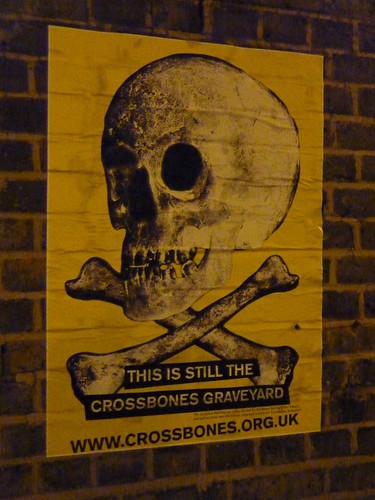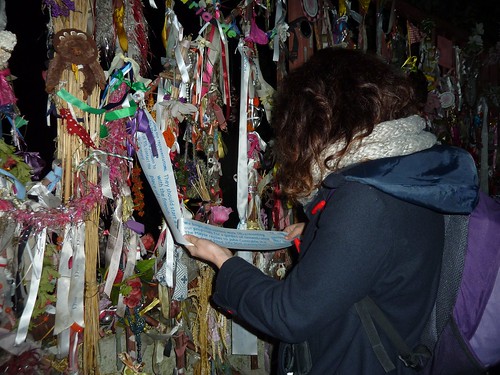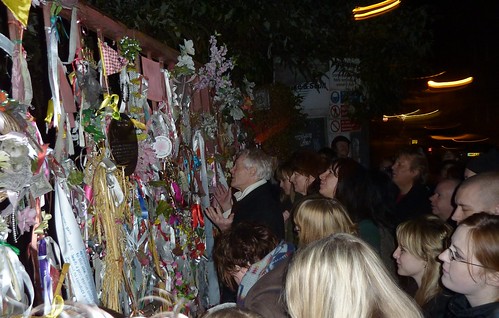We're off the tourist track a lot lately, a phenomenon I attribute to my continuing and persistent unemployed state which means I've got a lot of time, but not a lot of money. As a result, those quirky, off-beat things that don't require you to pony up £15 and stand in a long queue on a Saturday afternoon, but do require a bit of local knowledge and flexibility of schedule are right up my alley. Today I finally get to blog about something that's been on my list for ages now, discovered on the sunny Sunday that I rode a Brompton around the City. It's either quirky, or weird, or spiritual, or stupid, or cool, depending on your mood.
Crossbones graveyard is a mass burial ground on the south side of the Thames, not far from London Bridge. Back in the day, the area south of the Thames was a bit of a Wild West, if you'll pardon the obviously directionally challenged analogy. The City of London was (and still is) on the north side of the river, where laws against bull and bear baiting, prostitution, and such perversely debauched practices as theatre were enthusiastically enforced. On the south side, in an area known as "The Liberty of the Clink", such practices were permitted. And yes, "the Clink" does refer to a prison. In fact, the prison called The Clink is the one from which we get the euphemism. It's just down the road from Crossbones and is now a somewhat cheesy tourist attraction (please try to contain your surprise). Activities in The Liberty of the Clink were under the jurisdiction of the Bishop of Winchester, who actually licensed prostitutes to work in the area, a bit of such stunning hypocrisy it's hard to credit, but true nonetheless. The prostitutes became known, therefore, as Winchester Geese.
The burial ground known as Crossbones was the unconsecrated final resting place for many of these women, who, despite the fact that their trade was allowed, could not be buried in hallowed ground. Along with them are interred a heart-breaking number of children (the two tend to go hand in hand of course), and site later became a more general pauper's grave. The earliest reference to it dates to 1598 (and implied that the site had already been in use for a long time) and the area was closed to burials in 1853 because it was "completely overcharged with dead". It lay largely unused until Transport for London started planning for the new Jubilee line extension between 1991 and 1998. Archeologists from the Museum of London conducted excavations in connection with the TFL work and estimates are that greater than 15,000 bodies were buried at the site. More than one third of these were infants and a further eleven percent were children under the age of one; the adult bodies were mostly women. And, since even the most flint-hearted bureaucrat would have trouble justifying building a power substation in the middle of a graveyard full of babies, the land is still unused and remains a fenced off vacant lot near the corner of Union Street and Recross Way.
And this is where it all starts to get a bit airy fairy. Since its rediscovery Crossbones has become a local landmark and a sort of non-denominational shrine to what's referred to as "the outcast dead". Much of this is driven by the work of John Constable, an actor and writer who lives in the area. Constable has composed an epic poem in the voice of one of the prostitutes, a spirit he calls "The Goose", saying the poem was revealed to him in one night, on the 23rd of November in 1996. In explaining this event, Constable says the writings "… were revealed by The Goose to John Crow at Crossbones... My shamanic double had somehow raised the Spirit of a medieval Whore, licensed by a Bishop, yet allegedly denied Christian burial…" The trickster John Crow is Constable's alter-ego, part spirit, part character, part shaman, and all a bit hard to swallow.
(And this is what I mean when I say it gets a bit airy fairy. It's really hard to know how to approach the whole topic, and I admit I've been having trouble finding a voice for this post that's respectful on one hand, but appropriately sceptical on the other, and still with a good splash of the smart-ass blogger that is, admittedly, my own alter-ego. Nonetheless, let us plough on.)
Constable now conducts a vigil at the gates of Crossbones on the 23rd of every month (held on that date as a nod to the night in 1996) and that's what I attended last week, along with my friend Emma, who has already appeared in the blog. The Crossbones website has this to say about the vigils:
The vigil was as you might expect. John Constable was there and did most of the talking, telling us about the history of the site and the area in general, which was all interesting. And you may not be surprised to learn there was a generously large dose of that particular kind of non-denominational modern "I'm-not-religious-but-I-am-spiritual" business that a smart ass blogger might call "malarky" and a more generous soul would see as "ritual". For instance, the event was started when John dinged together a tiny pair of suspended cymbals at the stroke of seven pm, and then banged away on one of those little spinning hand drums. There were chants that the more experienced people in the crowd recited, along with the inevitable incense and candles and people with guitars who performed songs they'd written.
Much of the focus of the ritual is on the concept of "The Goose" which is meant to personify the spirit of the Winchester Geese who are buried at Crossbones, and, by extension, all of "The Outcast Dead". In this way it's actually a nice sentiment. And because it was the November vigil, and John Constable's poem was revealed to him on that night in November of 1996, every November vigil has the pleasure of hearing John perform his poem live. This was quite good, as the poem itself is lyrical and interesting. I enjoyed it, though I admit my thought process did go a bit like this:
After it was over Emma and I retired to a lovely old wine bar that was about two and a half steps across the road where we tried to process what we'd just seen and then got distracted by the realisation that we were unexpectedly sitting at a table right next to a cousin of Emma's whom she hadn't seen in a while, leading to the cousin and his girlfriend joining us for a few more drinks and some friendly conversation, and leading whatever profound insight Emma and I had been on the verge of articulating to be lost forever in the deep upholstery and raised panelling and red wine.
And that was my evening at Crossbones. I wish I could be a bit less cynical about the whole thing because they seem like lovely people and the sentiment was certainly genuine. Luckily, there one thing I can recommend unreservedly: the Friends of Crossbones have an online petition that I'm totally in favour of. Despite their incense and their chanting (which you may now realise I can't really get behind) the idea that this site should be preserved and remembered in an appropriate and sensitive way is one that I am completely in favour of. I signed it, and you don't have to be a Londoner, or even live in England to do the same, so here's the link, decide for yourself: Crossbones Petition.
P.S. There are a lot of videos on Youtube about Crossbones, I think this one gives the best sense of who John Constable is, and what the place is like, and the ritual and people involved. It's about ten minutes long. (Note: this shows people getting through the gates and onto the site itself, which was not part of the vigil I attended.)
Crossbones graveyard is a mass burial ground on the south side of the Thames, not far from London Bridge. Back in the day, the area south of the Thames was a bit of a Wild West, if you'll pardon the obviously directionally challenged analogy. The City of London was (and still is) on the north side of the river, where laws against bull and bear baiting, prostitution, and such perversely debauched practices as theatre were enthusiastically enforced. On the south side, in an area known as "The Liberty of the Clink", such practices were permitted. And yes, "the Clink" does refer to a prison. In fact, the prison called The Clink is the one from which we get the euphemism. It's just down the road from Crossbones and is now a somewhat cheesy tourist attraction (please try to contain your surprise). Activities in The Liberty of the Clink were under the jurisdiction of the Bishop of Winchester, who actually licensed prostitutes to work in the area, a bit of such stunning hypocrisy it's hard to credit, but true nonetheless. The prostitutes became known, therefore, as Winchester Geese.
Photo of the plaque on the gates, taken on that Sunday afternoon bicycle tour.
Crossbones poster, on Union Street
(And this is what I mean when I say it gets a bit airy fairy. It's really hard to know how to approach the whole topic, and I admit I've been having trouble finding a voice for this post that's respectful on one hand, but appropriately sceptical on the other, and still with a good splash of the smart-ass blogger that is, admittedly, my own alter-ego. Nonetheless, let us plough on.)
Constable now conducts a vigil at the gates of Crossbones on the 23rd of every month (held on that date as a nod to the night in 1996) and that's what I attended last week, along with my friend Emma, who has already appeared in the blog. The Crossbones website has this to say about the vigils:
Vigils have been held on the 23rd of every month since June 2004. They are inclusive, secular events, open 'to all faiths and none'... Please bring a flower, a ribbon, a totem, a memento to tie to the shrine at the gates. FREE - donations welcome.Naturally Emma and I didn't read the thing soon enough to equip ourselves with ribbons, totems or mementos of any kind, but we went anyways, and when we arrived there was a crowd of about 20 people gathered in the dark outside the steel gates to the site. The gates themselves have become quite a sight. After more than a hundred vigil's worth of mementos, they're festooned with layer upon layer of tokens and what-nots.
Here's Emma, examining one of the many ribbons on the gates to Crossbones. Some of them commemorate the dead of long ago, but many acknowledge current sex workers, and the site has become something of a touchstone for them and those who work with them.
Not a great photo, but it was dark and I was loathe to bust out the flash
"Hey, this is cool... this guy is obviously a trained actor, and that poem is quite good... interesting language... hmmm it's a bit cold out here... he's still at it... wow, that's a lot of lines to learn... still good though... gosh, still?... really?... starting to phase out here... look at all those ribbons... oh God, does that guy have a guitar?... my goodness, I guess this is what they mean by 'epic'..." and so on.And then he stopped, and said something like (I'm not kidding) "And that's just over half of the poem." Here's the first stanza (one of 34,518-ish):
There was also a call for anyone in the crowd to contribute a reading or a song or other remembrance or whatever. This is when the compulsory guitar people stepped up, and a little girl in the crowd also sang a couple of songs that were, objectively speaking, awful. (But also cute and totally acceptable because she was about 8 years old and she sang two songs, unaccompanied, in front of a crowd of strangers, so good on her.) Ribbons were made available for anyone who wanted to leave one on the gate, and the ceremony culminated in some more general chanting: "Goose may you never be hungry! Goose may you never be thirsty! Goose may your spirit fly free!" Finally, a whole bottle of gin was poured out on the ground in a large circle encompassing all the people, guitars and candles. (Gin, of course, was the favoured tipple of London's wretched poor, especially in the 18th century, and hence is powerfully symbolic, of course.)'I was born a Goose of Southwarkby the Grace of Mary Overiewhose Bishop gives me licenceTo sin within The Liberty.'
John Constable, at the gates
And that was my evening at Crossbones. I wish I could be a bit less cynical about the whole thing because they seem like lovely people and the sentiment was certainly genuine. Luckily, there one thing I can recommend unreservedly: the Friends of Crossbones have an online petition that I'm totally in favour of. Despite their incense and their chanting (which you may now realise I can't really get behind) the idea that this site should be preserved and remembered in an appropriate and sensitive way is one that I am completely in favour of. I signed it, and you don't have to be a Londoner, or even live in England to do the same, so here's the link, decide for yourself: Crossbones Petition.
We, the undersigned, call on Transport For London and all other interested parties to support the protection and conservation of the Cross Bones Memorial Gates and to work towards the creation of a Memorial Garden and public park on the historically sensitive site of the Cross Bones Graveyard adjoining Redcross Way and Union Street.I do honestly think that the Friends of Crossbones are doing an indisputably good thing by making sure the site is not forgotten (again), paved over (again), and turned into a mobile phone shop, a Starbucks, and Tesco Express. I just wish they could do it in a way that's slightly less flaky. I mean c'mon... incense?
P.S. There are a lot of videos on Youtube about Crossbones, I think this one gives the best sense of who John Constable is, and what the place is like, and the ritual and people involved. It's about ten minutes long. (Note: this shows people getting through the gates and onto the site itself, which was not part of the vigil I attended.)








0 Comments:
Post a Comment